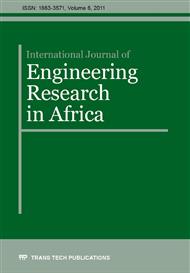p.1
p.13
p.25
p.37
p.45
p.65
p.75
The Effects of Composition on the Physical Properties of Locally Mined Ceramic Clays in the Atwima Nwabiagya District of Ghana
Abstract:
This paper reports work done which seeks to enhance the insulating property of locally mined clays with application to the building and insulation of medium temperature furnaces. Mixtures of locally mined clays with kaolin obtained from Teleku bokasso in the Western Region of Ghana were made. Samples were mixed in different ratios to form composite bodies in the form of bricks of dimensions 7mm×7mm×7mm cast at constant pressure and sintering temperature of 1000 °C. The clays used were characterized in terms of their particle size and chemical composition. The thermal resistivity, water absorption, weight loss, shrinkage, porosity and strength of samples were determined. The results showed that for all samples studied, an increase in Teleku bokasso clay enhanced the insulating properties of the samples from an average of 0.24% for samples containing 20% Teleku bokasso to approximately 2% for samples containing 60% of Teleku bokasso. Mixtures of Teleku bokasso with Afari clay were on the average 1% more thermally resistant than those of Mfensi. Sample A3 (with 40% Teleku bokasso with Afari) is recommended for the building of local furnaces because it had its strength more than doubled (105%) and was by 2% more resistant to heat than M3 (40% Teleku bokasso with Mfensi). All samples showed low weight loss levels, low water absorption, good linear shrinkage and compressive strength.
Info:
Periodical:
Pages:
25-35
Citation:
Online since:
November 2011
Authors:
Keywords:
Price:
Сopyright:
© 2011 Trans Tech Publications Ltd. All Rights Reserved
Share:
Citation:


